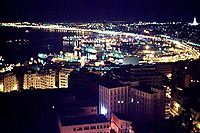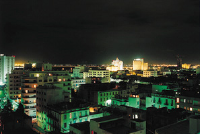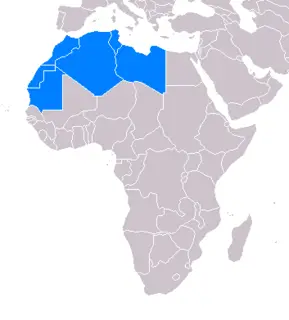Maghreb
The Maghreb (المغرب العربي al-Maġrib al-ʿArabī; also rendered Maghrib (or rarely Moghreb) is a collection of countries in the northern portion of the African continent that lie along the Mediterranean Sea and the Atlantic Ocean. The modern definition of the Maghreb includes: Mauritania, Morocco, Algeria, Tunisia, and Libya, although former definitions of the region where not limited to these five countries. The earliest definitions of the Maghreb were geographically quite broad, as the word Maghreb simply refers to meaning "place of sunset" or "western" in Arabic.
Geography
The Maghreb is primarily defined through a series of physical geographic features that seperate the area from the rest of Africa. The first feature to shape the Maghreb is the Atlas Mountain Range, which define the region's northern border. The Atlas Mountains provide a series of plateaus that recieve an annual rainfall of over 100mm a year. Not all the regions of the Maghreb are lucky enough to recieve the same steady rainfall as the Atlas Mountains, as the southern portions of the Maghreb fall within the dry lands of the Sahara. While the size of the desert zone varies among the countries in the Maghreb, with it consuming about half of Tunisia but over eighty percent of Algeria, the desert environment impacted growth and devlopment in the Maghreb. In particular, the broad expanse of the Sahara to the South and the trechorous Atlas mountains to the North led the Maghreb to develop a closely knit culture based on physical proximity. The geographic isolation of the Maghreb also led to formation of an independent trade system that tied together the population along economic lines.
Culture
Population


Traditionally, the MAghreb has been linked to the Middle East through linguistic and cultural ties. Even today, a majority of the population of the Maghreb identifies as Arab, despite the fact that the Berber people were actually the first population group to inhabitate the region. The remaining Berbers in the area, while a minority to the Arab identifying population, represent a sizable portion of the population in Morocco and Algeria. Ethnic groups boasting smaller populations that those of the Arabs and the Berbers also exist in the Maghreb, notably enclaves of Europeans settlers, who fled the to Africa seeking fortunes or asylum from pursecution, and a substantial Turkish population in Tunisia and Algeria.
Religion
The Maghreb region first experienced religious unity under the rule of the Roman Empire in the Pax Romana from 27 B.C.E. and 180 C.E. With the Roman Empire dominating the region, a period of political stability was ushered in that allowed individuals to practice relgion without being threatened. Eventually, the Maghreb became a cultural and religious center where the new ideas of Christianity were discussed. By the second century the ideas of Christianity had taken root in the Maghreb and the area boasted a a rich Christian culture, including among its population the writer Tertullian (c 155 - c 202), many Christian Church martyrs, leading figures such as St Cyprian of Carthage , Righteous Monica and her son the philosopher Augustine, Bishop of Hippo I, and St Julia of Carthage (5th century).
The first challenge to religious homogeny in the region came in 429 C.E. when the Vandals led a series of attacks along the African Mediterranean coast. Under the leadership of King Gaeseric the Vandals waged a highly sucessful campaign, which culminated in the Vandals achieving control over much of the Maghreb by 442. The Catholic Church played a major role in opposing the Vandal rule, a position which turned the military invasion into a conflict of relgigious ideologies, with Catholisism pitted the Aryan beliefs of the Vandals. The Catholics suceeded in removing the Vandals from power by 533 C.E.
In 647 C.E. the Maghreb again faced religious turmoil, when and Arab invasion forcibily introduced Islam to the region. While Islam quickly gained converts, Christianity continued to be actively and widely practiced in the area. In fact, the Christian population was large enough in the ninth century to cause Pope Benedict VII (974-983) to consecrate a new Archbishop of Carthage. Beginning with the tenth century, however, records of actively practiced Christianity are very sparse. [citation needed] Islam had succeeded Christianity as the religion of the majority.
While Islam has remained the predominant relgion since the first Arab invasion in 647 C.E., small communities of minority relgions have managed to coexist peacefully in the Maghreb. A notable minority population is Jewish community, many of whose members fled to the Maghreb in the tenth century from Baghdad, where social and political conditions had rendered it unsafe for them to practice their faith. From this origin exodus to Mahreb, a unique Jewish identity called the Maghribis emerged, where Jewish men involved in trade passed this identification on to their sons.[1]
History
The Pre-Colonial Period
From the end of the Ice Age, when the Sahara dried up, contact between the Maghreb and sub-Saharan Africa was apparently extremely limited. Arab expansion and the spread of Islam pushed the development of trans-Saharan trade, which while restricted due to the cost and dangers, was important and highly profitable, trading such goods as salt, gold, ivory, and slaves available from the Sahel regions.
Paleo-anthropological evidence suggests that originally most of the Maghreb was inhabited by "Caucasoid" Cro-Magnoids (Iberomaurusians) in the north. Later, about 8000 B.C.E., there came from the east "Caucasoid" speakers of northern Afro-Asiatic languages such as Berber at least since the Capsian culture.
Many ports along the Maghreb coast were occupied by Phoenicians, particularly Carthaginians; with the defeat of Carthage, many of these ports naturally passed to Rome, and ultimately it took control of the entire Maghreb north of the Atlas Mountains, apart from some of the most mountainous regions like the Moroccan Rif.
The Arabs reached the Maghreb in early Umayyad times, but their control over it was quite weak, and various Islamic "heresies" such as the Ibadis and the Shia, adopted by some Berbers, quickly threw off Caliphal control in the name of their interpretations of Islam. The Arabic language became widespread only later, as a result of the invasion of the Banu Hilal (unleashed, ironically, by the Berber Fatimids in punishment for their Zirid clients' defection) in the 1100s. Throughout this period, the Maghreb fluctuated between occasional unity (as under the Almohads, and briefly under the Hafsids) and more commonly division into three states roughly corresponding to modern Morocco, western Algeria, and eastern Algeria and Tunisia.
After the Middle Ages, the area east of Morocco was loosely under the control of the Ottoman Empire.
The Colonial Period
After the 19th century, it was colonized by France, Spain and later Italy.
The Post-Colonial Period
Today over two and a half million Maghrebins live in France, especially from Algeria, as well as many more French of Maghrebin origin. [citation needed]
Modern territories of the Maghreb
Medieval regions of the Maghreb
- Ifriqiya
- Djerid
- Sous
- Zab
- Hodna
- Rif
- Maghreb al-Awsat (Central Maghreb)
- Morocco (Maghreb al-Aqsa)
- Tamesna
- Tripolitania
References and notes
- ↑ Avner Greif (June 1993). "Contract Enforceability and Economic Institutions in Early Trade: The Maghribi Traders' Coalition". American Economic Association in its journal American Economic Review. Retrieved 2007-07-11.
- Cook, Chris and John Stevenson. The Longman Handbook of World History since 1914. Longman Inc., New York. 1991. ISBN 0582485886
- Mostyn, Trevor. ed. The Cambridge Encyclopedia of the Middle East and North Africa. Cambridge University Press, Cambridge. 1988. ISBN 0521321905
- The Maghreb Center Retrieved August 19, 2007.
See also
- Arab Maghreb Union
- Barbary Coast
- Berber
- Moors
- History of Algeria
- Maghreb toponymy
- North Africa
- Tamazgha
- Mashriq
- Northwest Africa
- Maghrebi script
- Jews and Judaism in North Africa
External links
| Regions of the world | |||||||||||||||||||||||||
|---|---|---|---|---|---|---|---|---|---|---|---|---|---|---|---|---|---|---|---|---|---|---|---|---|---|
|
| ||||||||||||||||||||||||
| See also Continents of the world | |||||||||||||||||||||||||
Credits
New World Encyclopedia writers and editors rewrote and completed the Wikipedia article in accordance with New World Encyclopedia standards. This article abides by terms of the Creative Commons CC-by-sa 3.0 License (CC-by-sa), which may be used and disseminated with proper attribution. Credit is due under the terms of this license that can reference both the New World Encyclopedia contributors and the selfless volunteer contributors of the Wikimedia Foundation. To cite this article click here for a list of acceptable citing formats.The history of earlier contributions by wikipedians is accessible to researchers here:
The history of this article since it was imported to New World Encyclopedia:
Note: Some restrictions may apply to use of individual images which are separately licensed.
